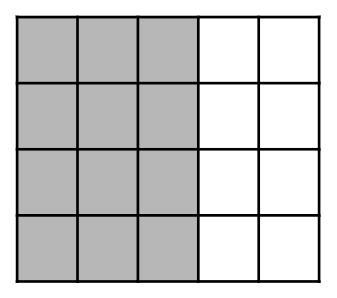Myths about teaching can hold you back


- Year 5
Use the language of equivalent fractions correctly
I can use the language of equivalent fractions correctly.


- Year 5
Use the language of equivalent fractions correctly
I can use the language of equivalent fractions correctly.
These resources were made for remote use during the pandemic, not classroom teaching.
Switch to our new teaching resources now - designed by teachers and leading subject experts, and tested in classrooms.
Lesson details
Key learning points
- Equivalent fractions have different numerators and denominators but represent the same value.
- Equivalent fractions have the same position on a number line.
- Equivalent fractions represent the same quantity or area.
Keywords
Equivalent fractions - Equivalent fractions are fractions which have the same value, even though they may look different.
Proportion - The proportion of a number, shape or group of objects is a part of the whole.
Common misconception
Children learn how to spot and create equivalent fractions without realising that they have the same value and have the same position on a number line. The understanding of equivalence is important.
Use the = symbol to record fractions with the same value and the language 'is equal to'. Make use of manipulatives and representations to model equivalence and highlight the equality.
To help you plan your year 5 maths lesson on: Use the language of equivalent fractions correctly, download all teaching resources for free and adapt to suit your pupils' needs...
To help you plan your year 5 maths lesson on: Use the language of equivalent fractions correctly, download all teaching resources for free and adapt to suit your pupils' needs.
The starter quiz will activate and check your pupils' prior knowledge, with versions available both with and without answers in PDF format.
We use learning cycles to break down learning into key concepts or ideas linked to the learning outcome. Each learning cycle features explanations with checks for understanding and practice tasks with feedback. All of this is found in our slide decks, ready for you to download and edit. The practice tasks are also available as printable worksheets and some lessons have additional materials with extra material you might need for teaching the lesson.
The assessment exit quiz will test your pupils' understanding of the key learning points.
Our video is a tool for planning, showing how other teachers might teach the lesson, offering helpful tips, modelled explanations and inspiration for your own delivery in the classroom. Plus, you can set it as homework or revision for pupils and keep their learning on track by sharing an online pupil version of this lesson.
Explore more key stage 2 maths lessons from the Comparing fractions using equivalence and decimals unit, dive into the full primary maths curriculum, or learn more about lesson planning.

Licence
Prior knowledge starter quiz
6 Questions
Q1.Which of these fractions would be closest to 0 on a 0 to 1 number line?
Q2.Which of these fractions would be closest to 1 on a 0 to 1 number line?
Q3.Which of these fractions would be closest to $${1}\over{2}$$ on a 0 to 1 number line?
Q4.Which of these fractions would sit between 0 and $${1}\over{2}$$ on a 0 to 1 number line?
Q5.Which fractions have the same value as $${1}\over{2}$$?
Q6.Order these fractions from the smallest to the largest.
Assessment exit quiz
6 Questions
Q1.Match the pairs of equivalent fractions you can see in the image.

$${1}\over{2}$$ -
$${4}\over{8}$$
$${5}\over{10}$$ -
$${15}\over{30}$$
$${4}\over{8}$$ -
$${15}\over{30}$$
$${15}\over{30}$$ -
$${1}\over{2}$$
Q2.Which fractions could you use to describe the shaded fraction of this bar?

Q3.Which fractions represent the shaded area of the shape?

Q4.Which fractions represent the highlighted part of the number line?


